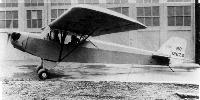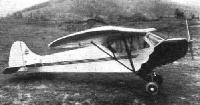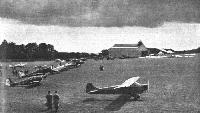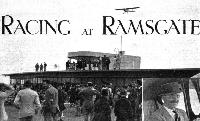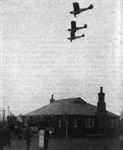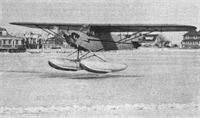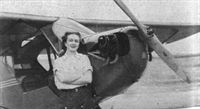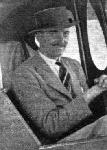
Варианты
- Taylor - Cub - 1931 - США
- Piper - Cub J-3/J-4 / L-4 Grasshopper / PA-11 - 1937 - США
- Piper - Cruiser J-5 / L-14 / PA-12 / PA-14 - 1939 - США
- CNNA - HL-1 - 1940 - Бразилия
- Piper - TG-8 - 1941 - США
- CAP (Paulista) - CAP-4 Paulistinha - 1945 - Бразилия
- Piper - Super Cub PA-18 / L-8 / L-21 - 1949 - США
- Miller - Twin / M-6 - 1957 - Великобритания
- LIPNUR - NU-85 Belalang / NU-90 - 1958 - Индонезия
- Datwyler - MDC-Trailer - 1962 - Швейцария
- Wag-Aero - CUBy / Wag-A-Bond - 1975 - США
- CubCrafters - Carbon Cub EX / XCub - 2008 - США
Taylor Chummy и Cub
"Taylor Brothers Aircraft Corporation" развернула свой бизнес в США в конце 1920-х годов. Первым ее изделием стал самолет Taylor Chummy - легкий двухместный подкосный высокоплан с закрытой кабиной для двух человек, размещавшихся бок о бок.
Chummy, оснащенный звездообразными моторами Kinner K5 или Brownback Tiger мощностью 50 л. с., быстро стал популярен, но экономическая ситуация в 1928 году, когда началось серийное производство, резко ухудшилась, из-за чего массовым он не стал. Фирма переехала в Бредфорд, Пенсильвания, и сменила название на "Taylor Aircraft Company". Но нехватка финансов заставила прекратить выпуск самолета Chummy.
Президент, главный конструктор и главный инженер С. Гилберт Тейлор, разработал улучшенный двухместный Cub E-2 с 37-сильным мотором Continental A40. Благодаря агрессивной рекламной кампании удалось построить более 300 таких самолетов. Фирма в итоге сумела пережить кризис.
Далее появились Cub F-2 с 40-сильным мотором Aeromarine AR3-40 (построено около 30), Cub H-2 с 35-сильным мотором Szekely SR-3-35 (построено четыре) и, в конечном итоге, очень удачный улучшенный Cub J-2 с возможностью установки мотора Continental A40 мощностью 37 или 40 л. с.
До уничтожения производственной линии пожаром в 1937 году было построено более 1200 Cub. После пожара Тейлор оставил фирму. Еще 63 самолета собрала "Aircraft Associates Inc." из Лонг-Бич, Калифорния, после покупки прав на самолет у Тейлора. Далее выпуском этого самолета, получившего наименование Piper Cub, занялся Уильям Т. Пайпер.
Описание:
- Taylor Chummy и Cub
- Flight, July 1937
A LITTLE CUBBING
Фотографии
-
Aeroplane Monthly 1999-12 / E.Dumigan - Something for the weekend /Museum report/
Регистрационный номер: NC17834 The museum’s Taylor Cub proudly sits in the entrance to attract the attention of air-minded shoppers.
-
Air-Britain Archive 1983-01
This is the way the Cub was sold - one of the Taylor Brothers advertisements for the E-2 which appeared in 'National Power Glider' in December 1930.
-
Air-Britain Archive 1983-01
Регистрационный номер: N13179 The design from which all later Cubs were derived, a Taylor E-2 Cub N13179, c/n 60, at Oshkosh in 1972
-
Мировая Авиация 245
Регистрационный номер: NC12626 Первым серийным вариантом семейства Cub был Taylor E-2, оснащенный двигателем Continental A-40. Обратите внимание на открытую с бортов кабину и угловатую форму вертикального оперения.
E-2 Cub серийно выпускался в 1931-1936 годах с моторами Continental MO-2 или Continental A40-3. -
Aeroplane Monthly 1981-01 / News Spotlight
Регистрационный номер: C-GCGE Garth Elliot’s rare Taylor E-2 Cub, seen recently at Burbank International, was built in August 1933 and flew in July 1980 for the first time in 41 years. Registered C-GCGE the E-2 is powered by a 40 h.p. Continental and cruises at 56 m.p.h.
-
Air-Britain Archive 1983-01
Регистрационный номер: NC17246 J-2 Cub NC17246, c/n 912, at Keene, New Hampshire on 23.6.47, remained on the US Civil Register until 1970.
-
Flight 1937-01 / Flight
Регистрационный номер: NC17258 LANDLUBBING "MAYO": One Mike Murphy lifts his Taylor Cub from the roof of an obliging automobile at Miami.
-
Air-Britain Archive 1983-02
Регистрационный номер: NC17509 NC17509 (c/n 1009) photographed at Keene, New Hampshire, on 21.10.50 while wearing a J-3 style fin and rudder.
-
Air-Britain Archive 1983-02
Регистрационный номер: NC17512 Also at Keene, NH, this time during 1942, was NC17512 (c/n 1012) though the striped object defies identification!
-
Air-Britain Archive 1983-02
Регистрационный номер: N17834 N17834 (c/n 1269) on static display at its home base of Rhinebeck, New York, on 28.8.76.
-
Air-Britain Archive 1983-02
Регистрационный номер: NC17854 Seen at Oshkosh in 1973 NC17854 (c/n 1289) retained its prewar prefix but crashed on 5.8.73. Happily it was rebuilt and is again airworthy.
-
Air-Britain Archive 1983-03
Регистрационный номер: N19554 Carrying its registration in triplicate, N19554 (c/n 1754) was an Oshkosh visitor in 1977.
-
Air-Britain Archive 1983-03
Регистрационный номер: NC19565 NC19565 (c/n 1765) at Oscaloosa, Iowa in September 1960. The badge on the fuselage celebrates Minnesota Centennial 1858-1958, the Cub then being based at St.Paul, Minnesota.
-
Air-Britain Archive 1983-03
The Cub, taken at Portsmouth, New Hampshire on 6.5.A7, has an extremely indistinct registration. Charles Trask labelled the print NC15845 but this does not appear to have been a J-2 registration, the editorial magnifying glass and reference to the production list have suggested NC16955 or NC16958 as possibles!
-
Flight 1937-07 / Flight Advertisements
The 1937 Cabin Cub
-
Flight 1937-03 / Flight Advertisements
Регистрационный номер: G-AEIK [3] -
Flight 1936-06 / Flight
Регистрационный номер: G-AEIK [3] Mr. Beard, the pilot of the interesting little American machine, the Taylor Cub, which was virtually a non-starter owing to carburation difficulties. The opening action at the side is noteworthy.
-
Aeroplane Monthly 1988-05 / Personal album. Civil
Регистрационный номер: G-AEIK [3] Piper (Taylor) J-2 Cub G-AEIK, seen here at Lympne in 1936, is historically important because it was the first Piper aircraft to be imported into the UK.
-
Aeroplane Monthly 1987-04 / M.Jerram - For Business and Pleasure
Регистрационный номер: G-AEXY [2] Taylor J-2 Cub G-AEXY, built by Taylor Aircraft at Lockhaven, was registered in July 1937. In March 1953 it was sold in Spain.
-
Air-Britain Archive 1983-03
Регистрационный номер: G-AEXY [2] By way of a postscript we have two photographs recently received from Gordon Riley of Vintage Aircraft magazine. They show G-AEXY (971) and G-AEXZ (997) when both aircraft were new and owned by the County Flying Club at Rearsby, this photo being taken during the winter of 1938/9 by V.H.Doree. Gordon comments that both Cubs were silver overall, one having blue trim and the other red, but does anyone know which was which?
-
Air-Britain Archive 1983-02
Регистрационный номер: G-AEXZ [4] The only J-2 Cub left on the British register, G-AEXZ (997) is still active and is shown here at Sywell on 3.7.76.
-
Aeroplane Monthly 1987-04 / M.Jerram - For Business and Pleasure
Регистрационный номер: G-AEXZ [4] Sister-ship J-2 G-AEXZ, shortly to fly again.
-
Мировая Авиация 245
Регистрационный номер: G-AEXZ [4] Удачный Taylor J-2 Cub больше известен как предшественник классических высокопланов Piper Cub. На фотографии: самолет постройки 1938 года с британской регистрацией.
-
Air-Britain Archive 1983-03
Регистрационный номер: G-AEXZ [4] The County Flying Club's Taylor Cub probably during the winter of 1937/38. This G-AEXZ being wheeled out at Rearsby, aircraft is still based in Leicestershire.
By way of a postscript we have two photographs recently received from Gordon Riley of Vintage Aircraft magazine. They show G-AEXY (971) and G-AEXZ (997) when both aircraft were new and owned by the County Flying Club at Rearsby. Gordon comments that both Cubs were silver overall, one having blue trim and the other red, but does anyone know which was which? -
Aeroplane Monthly 1988-02 / M.Oakey - Grapevine
Регистрационный номер: G-AFFH [2] A period shot of Piper J-2 Cub G-AFFH, currently under restoration by Wiltshire-based enthusiast Martin Honeychurch. He has acquired a Continental A-40 side-valve engine to power the aircraft, which was recovered from Spain last spring.
-
Air-Britain Archive 1983-03
Регистрационный номер: CF-RDS Active in Canada for over twenty years, CF-RDS c/n 1531 was photographed a t Lake St.John, Ontario on June 14th 1973.
-
Air-Britain Archive 1983-02
Регистрационный номер: C-GNGO One of the half-dozen J-2 Cubs currently registered in Canada, C-GNGO (c/n 1064) was an Oshkosh visitor in 1979.
-
Air-Britain Archive 1983-01
Регистрационный номер: LN-EAN [2] A wintry shot of LN-EAN, c/n 961, on skis,
-
Aviation Historian 8 / R.Mulder - Capital Gains: Oslo-Fornebu airport 1934-40
Регистрационный номер: LN-EAN [2] Opening day, June 1, 1939; as well as the various airliners on show, three privately-owned aircraft were on hand to celebrate the airport’s inauguration. They were Taylor J-2 Cub LN-EAN (the tail of which is visible here), Taylorcraft A LN-FAG and Fairchild 24 LN-EAF. In the background is DNL’s Caproni Ca 310 LN-DAK Brevduen.
Другие самолёты на фотографии: Caproni Ca.310 Libeccio - Италия - 1937Fairchild C-61 Forwarder / Model 24 / Argus - США - 1932Taylorcraft A / B / C / F-19 / F-21 / F-22 - США - 1937
-
Air-Britain Archive 1983-01
Регистрационный номер: LN-FAB [2] Taylor J-2 Cub LN-FAB, c/n 980, "Fabian" is the oldest aircraft flying in Norway. It was photographed by Kay Hagby en route to the KZ-Rallye in June 1982.
-
Air-Britain Archive 1983-02
Регистрационный номер: LN-FAB [2] Another photo of LN-FAB? This is a much earlier shot of c/n 980 than the one published last time, probably taken in the late sixties. It aroused the interest of specialist Colin Smith who noticed that the letter B appears to have had the lower loop added later (to a P ?) and is rather badly aligned. Was the aircraft ever painted as LN-FAP, perhaps in error?
-
Air-Britain Archive 1983-02
Регистрационный номер: OH-CPE A fine piece of restoration in Finland, OH-CPE c/n 1157.
-
Air-Britain Archive 1983-01
Регистрационный номер: PP-TCT Very few J-2 Cubs were registered in South America. One which is believed to be still current is c/n 955, PP-TCT.
-
Jane's All the World Aircraft 1938 / 01 - The progress of the world in civil aviation during the year 1937-38
Регистрационный номер: VP-TAB TRINIDAD'S AERODROME. - In the absence of any other place to land aeroplanes on the island, Mr. F.D.St.Hilaire has prepared this field, 100 yds. by 1,000 yds., and flies his Taylor "Cub" from it.
-
Air-Britain Archive 1983-02
Регистрационный номер: ZK-AFQ [2] Taylor Cub ZK-AFQ (c/n 977) wearing a badge showing a swordfish and a volcano, date unknown.
-
Мировая Авиация 196
Регистрационный номер: ZK-AFQ [2] Первым действительно массовым самолетом в семействе стал J-2 Cub, построенный в 1935-1938 годах в количестве 1216 машин. Первоначальную цену в 1470 долларов в дальнейшем снизили до 1270 долларов.
-
Flight 1937-07 / Flight
The start: P. B. Elwell's Taylor Cub is seen getting away, and Alington's Dart Kitten is next in the line.
Другие самолёты на фотографии: Dart Kitten - Великобритания - 1937
-
Flight 1937-07 / Flight
An idea of the range of vision provided for the pilot of the Cub may be gathered from this view, which, however, does not show how the starboard side can be opened right up for summer flying.
-
Flight 1937-08 / Flight
Mr. Elwell brings his victorious Cub in over the attractive clubhouse at Ramsgate.
-
Flight 1938-07 / Flight
Three Taylor Cubs, representing the County Club’s fleet, fly in professional formation over the new clubhouse at Rearsby.
-
Aeroplane Monthly 1992-07 / D.Middleton - Propellers (1)
An interesting attempt at a simple VP propeller was the American Everel, dubbed the "amputated airscrew". The blade was pivoted on an oblique bearing and reacted to centrifugal and aerodynamic forces to change pitch through a limited range. It could be used only on small, low-powered aircraft, like the Cub.
Like most unorthodox pieces of machinery, the Everel airscrew looks a little uncouth until one becomes used to its appearance. -
Flight 1938-02 / Flight
Like most unorthodox pieces of machinery, the Everel airscrew looks a little uncouth until one becomes used to its appearance. In the picture is seen the take-off demonstration, with the Everel-fitted Cub nearest the camera; both had left the same mark simultaneously.
-
Flight 1937-03 / Flight
Регистрационный номер: NC17542 The American private-owner type: The Taylor Cub as a floatplane.
-
Flight 1940-08 / Flight
An idea which works. Capt. McKinley devised a pair of rubber floats for his light plane, and has demonstrated that they perform well both on water and on ice. The scheme might be applied to deflatable outboard floats for flying boats.
-
Air-Britain Archive 1983-02
Регистрационный номер: LN-FAD Another Norwegian Cub on floats, LN-FAD (c/n 981) also had additional rudders attached to the tailplane.
-
Flight 1939-01 / Flight
Регистрационный номер: G-AFFH [2] One-man seamanship: Jemima behaving obediently at the end of her painter.
-
Flight 1939-01 / Flight
Jemima on the slipway. The stabilisers on the tailplane are to counteract the effect of the forward float area.
-
Flight 1938-01 / Flight
8,000 MILES ON 40 H.P. Mr. J. Clancy (shaking hands) and Mr. R. H. Julius welcomed back by Mr. Bridgeland, secretary of the Royal Australian Aero Club, from a remarkable 8,000-mile flight round Australia in a Taylor Cub (40 h.p. Continental) by far the lowest-powered of the few machines which have ever made the circuit. Starting from Sydney and flying in an anti-clockwise direction, they made excellent progress, their only difficulties arising from primitive aerodromes and from navigational problems of the kind encountered when flying over hundreds of miles of territory virtually barren of any landmark. Between Perth and Adelaide they followed the longest stretch of dead straight railroad in the world - 400 miles. The other snapshot above shows a typical stretch of the uninviting country over which the little machine flew. Mr. Julius is a partner in the firm of Julius Gardiner and Co., of Sydney, who are handling the Cub in Australia, following an introduction by Mr. “Bill” Shackleton when he was visiting America some time ago.
-
Flight 1937-08 / Flight
A detailed view of Mr. Elwell.
-
Air-Britain Archive 1982-04
Регистрационный номер: ZK-AGD ZK-AGD Piper J-2 Cub at Wanganui 25.8.67 already in poor state.
-
Air-Britain Archive 1983-02
Регистрационный номер: LN-EAW Cub floatplane LN-EAW (c/n 979) after an accident at Drammen 21.5.39. It was repaired by 2.9.39 only to be written-off 3.40.
- Фотографии



